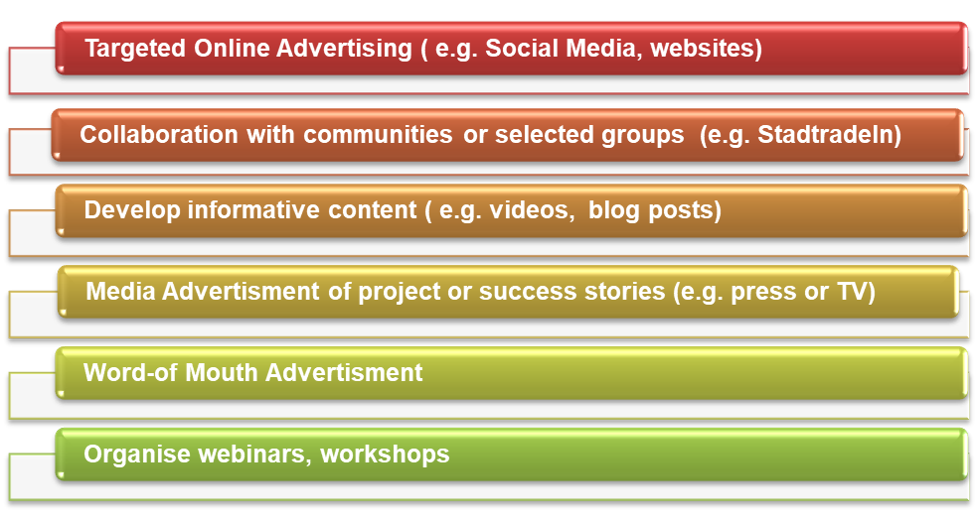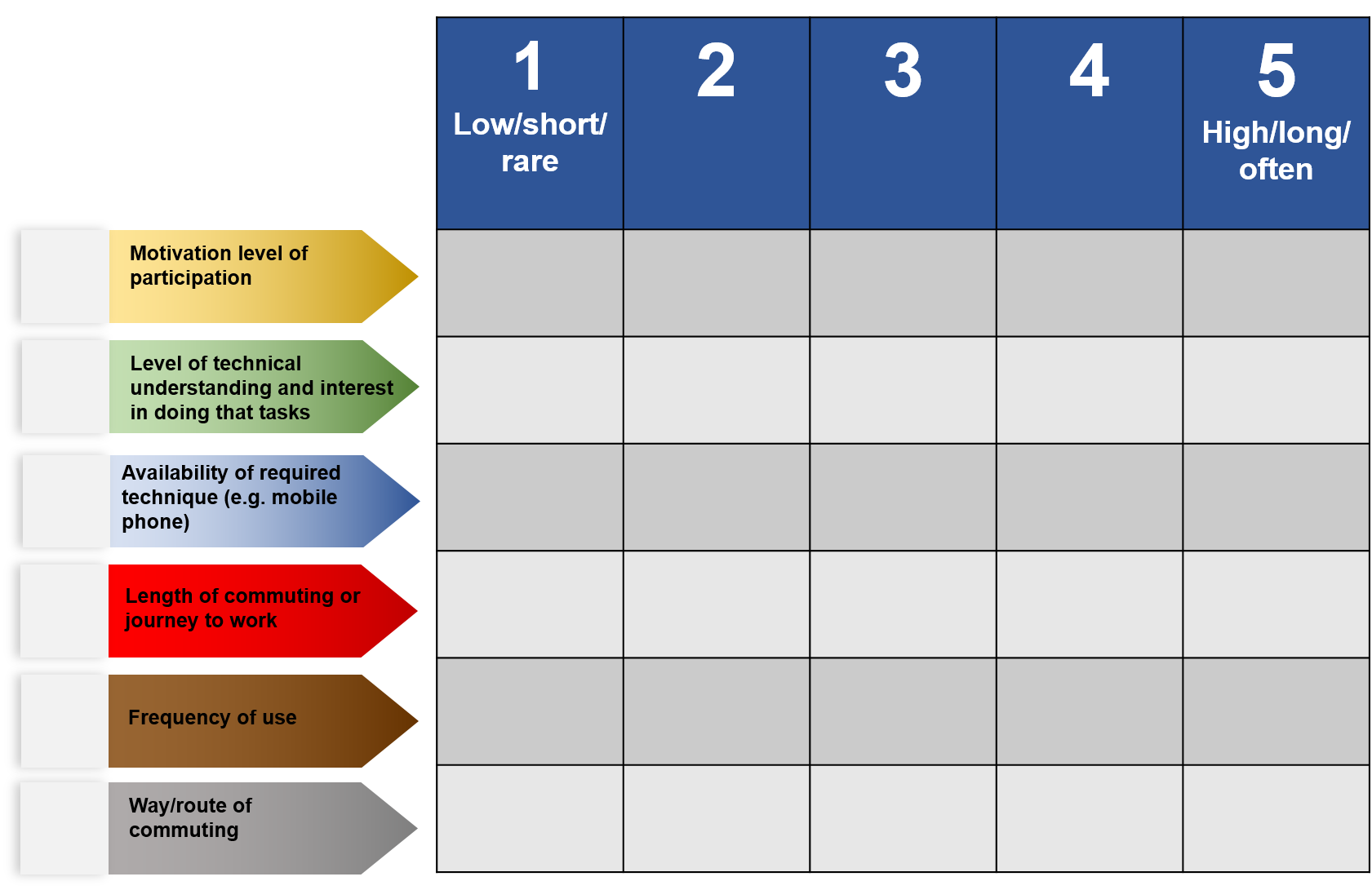Step 6: Recruitment and instruction of participants
Usually, the participation of citizens and other stakeholders in CS projects cannot be taken for granted, as it depends on many variables (e.g. motivation to participate, willingness to commit time and resources). Recruitment is a very critical and time-consuming task. Understanding the motivation of the citizens is also crucial for the success of a project and depends on the project tasks as well.
Recruiting strategies for Citizen Science projects are crucial to getting suitable participants involved. Visibility is increased through the use of online platforms, community partnerships and educational outreach.
Country-specific, cultural and ethical considerations are crucial for effective recruitment strategies in citizen science projects. Recruitment success is affected by cultural norms, which influence people's attitudes towards science and participation. In addition, ethical concerns such as data protection, consent and equitable representation have an impact on recruitment approaches. Adapting strategies to respect cultural sensitivities and ethical standards is essential for effectively engaging diverse populations. CS projects can maximise recruitment outcomes and facilitate meaningful scientific contributions from a global community by addressing country-specific, cultural and ethical factors.
The optimal recruitment strategy includes an optimal advertisement strategy, selection of the most suitable participants, strategy for optimal instruction and training, strategy for optimal communication and considering ethical and privacy issues.
Possible advertisement strategies to attract citizens include:

Optimal advertisment strategies should consider country-specific and cultural characteristics.
Usually, with the right promotion, many citizens are interested in participating in CS activities. In the CityCLIM project, mobile sensors were distributed to citizens in order to obtain data from all parts of the city. The following selection criteria were used to select participants from a larger interested group in the CityCLIM project.

These selection points will need to be evaluated and adapted to take account of the objectives specific to the country or the city.
The strategy for optimal education and training in citizen science projects is multi-faceted. It includes the design of accessible materials such as manuals tailored to different stakeholder groups, the inclusion of interactive elements for engagement (e.g., questionnaires, games, discussion forums and Q&A ses-sions, data visualisation, feedback and reflection), and the provision of ongoing support. The expertise of the citizens is improved by e.g. workshops, tutorials and online resources. Continuous feedback loops and evaluation mechanisms refine teaching approaches and ensure effectiveness. The emphasis on clear communication and the empowerment of participants with relevant skills cultivates confidence and commitment, ultimately enhancing the quality and impact of citizen science contributions to scientific research.
The CityCLIM project has developed easy-to-understand manuals for the sensors in the different national languages. In addition, webinars and workshops were organised by the project participants in the pilot cities prior to the start of the measurements to introduce the project, its objectives and the requirements for participation in the citizen science activities. Questions from citizens were also answered. Within the CityCLIM project, all citizens were also given the opportunity to contact the contact person in each pilot city at any time with questions or concerns. Initial data collected from citizens was presented and project results discussed on different social media channels. In addition, online and onsite workshops were organised to educate citizens about the sensors used and to answer questions.
Another point is that effective engagement of citizen scientists requires the use of different tools and platforms that facilitate communication, collaboration, data collection and information sharing. There does not seem to be a one-size-fits-all approach. The tools and platforms need to be adapted to the specific conditions and tasks in which citizen scientists are involved. Also, the main challenges of citizen engagement: at the beginning there is a lot of enthusiasm, citizens are usually very motivated, but over time things can get complicated. It is therefore necessary to maintain regular contact with participants.
The best communication practices to optimize the stakeholder engagement are:
- Start by identifying exactly how your stakeholders want to receive communications and what works best for them.
- Add a personalised communications touch
- Ensure that all information is presented in a transparent way
- Encourage stakeholders to share their ideas and input, listen actively and acknowledge ideas
- Identify barriers to engagement and remove them as far as possible (language issues, accessi-bility)
- Create a community for informal communication
- Establish stakeholder-friendly practices (when planning meetings, prioritise convenience and ac-cessibility, announce e.g. when planning meetings, prioritise convenience and accessibility, e.g. announce meetings through multiple communication channels)
- Communicate openly, honestly and transparently
- Be concise, provide a link to where they can find more information
- Use the best technological tools to engage a digital-centric community
- Determine which channel is ideal for communication
- Make it a priority to communicate consistently with key stakeholders
- Provide feedback to stakeholders on how their interests and issues are being addressed and re-solved
- Carefully record all aspects of stakeholder communication over time
Ethical issues relevant to citizen science projects cover a wide range of concerns. Privacy and data pro-tection are paramount, requiring informed consent and safeguards for participants' data. Equity and inclusivity require fair representation and accessibility for all involved citizens. Intellectual property rights and attribution ensure recognition of the work of the citizens. To mitigate unintended consequences, environmental and social impacts must be considered. Trust is fostered by transparency in project objectives, methods and results. Credibility and accountability are maintained through continuous ethical review and adherence to professional standards. Attention to these ethical considerations ensures respon-sible and ethical behaviour in citizen science endeavours, and is conducive to mutual benefit and societal progress.
Ethical and privacy issues in citizen science vary from country to country due to different legal frame-works, cultural norms and societal values. Data protection laws, consent requirements and expectations of privacy vary in different countries. Privacy and ethical issues in most countries are shaped by its legal framework, including data protection regulations like the GDPR. Ethical considerations are country- specific and influenced by cultural perspectives on community engagement, indigenous knowledge and research ownership. Therefore, cultural values that emphasise individual rights and privacy influence ethical considerations.
Questions to be answered when considering ethics and privacy issues in citizen science projects
| Aspects | Questions |
|---|---|
| Legal aspects |
• What are the legal requirements for ensuring participant privacy in citizen science projects? • Are there specific ethical guidelines that citizen science projects must adhere to? • How does the data protection legislation apply to citizen science projects that involve collecting and handling personal information? |
| Informed Consent |
• Have participants been adequately informed about the purpose, risks, and benefits of the project? • Do they understand how their data will be used and shared? |
| Privacy Protection |
• How will participant data be collected, stored, and shared? • Are there measures in place to anonymize or pseudonymize data to protect partici-pant privacy? • How will the project handle sensitive or personal information? |
| Data Ownership and Control |
• Who owns the data collected through the project? • Will participants have control over their data and be able to access, modify, or delete it? • How will data be used beyond the initial project? |
| Data Security |
• What measures are in place to ensure the security of participant data? • How will the project protect against unauthorized access, data breaches, or misuse? |
| Bias and Fairness |
• How will the project address potential biases in data collection or analysis? • Are there measures to ensure inclusivity and diversity among participants? |
| Community Engagement |
• How does the project involve and engage with the communities it affects? • Are there mechanisms for community feedback and input? |
| Benefit Sharing |
• How will the benefits of the project be distributed among participants, researchers, and the broader community? • Are there mechanisms for compensating or acknowledging participants' contribu-tions? |
| Ethical Oversight |
• Is there an ethics review process in place to evaluate and approve the project? • Are there mechanisms for ongoing ethical oversight and review? |
| Risk Assessment |
• What potential risks do participants face by participating in the project? • How will the project mitigate or manage these risks? |
| Long-Term Impacts |
• What are the potential long-term impacts of the project on participants, communities, and the environment? • How will the project monitor and evaluate these impacts over time? |
